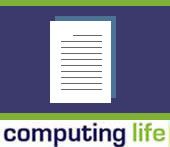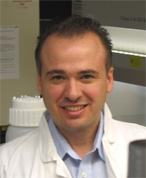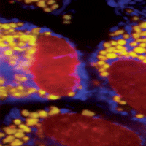
Overview of NIGMS and Computing Life
Searching for Genetic Treasures
The Next Top Protein Model
Movie Mania
Sim Sickness
Integrating Biology
Made Possible By ...
Web Extras: Movies, Podcasts, and Other Cool Stuff
"Computing Life" in PDF
Web Extras: Interview
Q&A: Virtual Drug Development
When native Colombian Gus Rosania first came to the United States in 1986 to attend college, he never thought he'd be a pharmaceutical scientist—a career option he didn't even know about until after graduate school.

Now a professor at the University of Michigan, he studies how small molecules, like those found in oral medications, make their way to the right cellular target and produce the desired effect. His academic research could lead to new and improved methods for drug discovery.
I talked to him about his work and the role of computational tools in the pharmaceutical sciences.
What do you study?
I look at the transport of small molecules inside cells. We try to relate the molecules' chemical structure to where it's localized inside cells. Understanding this relationship can tell us where to introduce modifications in the chemical structure that increase the potency and reduce the toxicity of certain drugs.
What's the goal of this research?
Ultimately, I'd like my research to impact the quality of drug products that are being developed by pharmaceutical companies and to impact the drug development process—make it less expensive and more efficient. I think one way to do this is to use computers to simulate the transport of different drug molecules.
You've already developed computer simulations of drug transport that you call "virtual crash test dummies." What are you learning from these virtual experiments?
The "virtual crash test dummies" are a computational tool for predicting which candidate drug molecules are most likely to accumulate where they're supposed to, so they exert the right therapeutic effect.
Right now, it takes a lot of time to identify possible drug candidates that later would be tested in clinical trials. Can you use the simulations to screen many drug candidates at one time?
You can assess millions of drug candidates on the computer very quickly and cheaply—it's essentially an overnight experiment.

Have you used the simulations to study existing drugs?
We actually do several things. First, we test our simulations with molecules that are fluorescent, so we can see where they go inside the body or cells. This lets us validate the models. Then, we can apply the models to drug molecules already on the market. Ultimately, one could use the models to study a new molecule.
Do you develop new drug molecules in your lab?
We don't develop these in my lab. Instead, we develop the tools and technologies that pharmaceutical scientists in industry can use for drug discovery.
To help you build the simulations, you rely on an approach called "chemoinformatics." What is this?
Chemoinformatics is the application of computational methods, statistics, and mathematics to study information about the structure, properties, and activities of molecules. In drug development, chemoinformatics is becoming increasingly important because there's a need for storing, handling, and analyzing large amounts of information associated with these compounds.
What do you like best about being a scientist?
Working on problems that I think are really important and that will change the way humanity does things is my favorite part about being scientist.
When you're not in the lab, what do you like to do?
I enjoy spending time with my wife and my two daughters. I like going to art museums and natural history museums—my 7-year-old loves fossils!
What advice do you have for students considering careers in the pharmaceutical sciences?
I think this is a great field to be in. We're figuring out how to translate major discoveries in chemistry, biology, genetics, and many others into applications that can benefit millions of people.